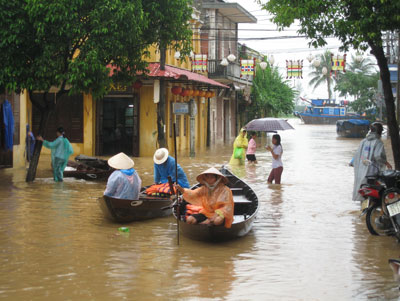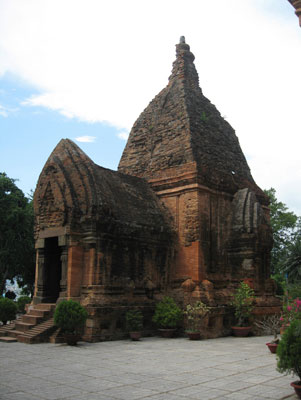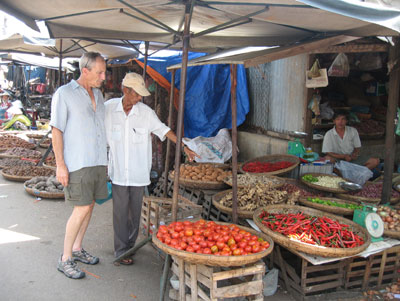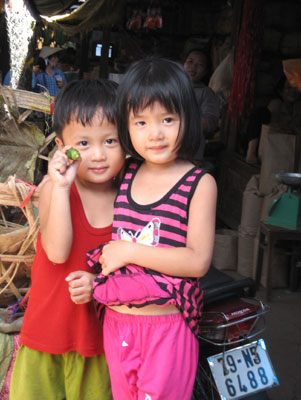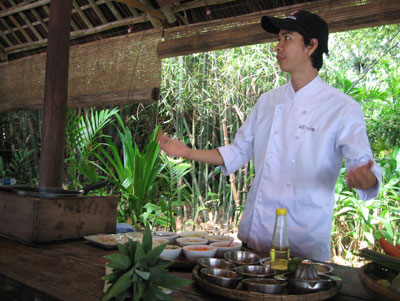Wandering – and wading – through south-central Vietnam
by Inga Aksamit, San Rafael, CA
As the warm water gently lapped over my ankles, I gazed at the setting sun — a romantic setting if only we were at the beach in Hoi An, Vietnam, rather than the front door of our hotel.
The milk-chocolate-brown water at my feet had crested over the banks of the nearby river two days before and was slowly inching toward our hotel six blocks away. Our available walking range on dry streets narrowed each day, necessitating appropriate footwear (plastic flip-flops) and ever-deeper submersion to get around.
Heading to dinner, we waded into water over our ankles and occasionally up to our knees, joining the crowds that took the rising waters in stride. Most shops and restaurants were open for business as usual, though some nearer the river had moved their wares to higher ground.
Learning that the river floods a couple of times a year, we weren’t surprised to see weather-specific entrepreneurial enterprises arise. Women materialized out of nowhere selling ponchos during downpours while others cajoled tourists into small pirogues to tour the flooded streets when the skies over the surging waters cleared.
My husband, Steve, and I were 10 days into our October ’08 exploration of Vietnam’s south-central coast and were moving with the rhythms of the towns we passed through, enjoying the slower pace compared to that in the bustling metropolis of Ho Chi Minh City (still referred to as “Saigon” by most locals we met).
Saigon
We had spent two days in Saigon adjusting to the heat and humidity and enjoying fresh seafood, French wine and market delicacies. Our accommodations ($50 per night) at The Spring Hotel (44-46 Le Thanh Ton St.; phone 848 3829 7362) were comfortable and clean though a bit dated.
The airport pickup ($15 for up to four people), in a new SUV, was a luxury we appreciated, given our 10 p.m. arrival time. Breakfast was also included and typically consisted of eggs cooked to order plus perfectly ripened, intensely flavored tropical fruits and the lightest, flakiest French rolls I’ve ever tasted.
While in Saigon we visited the small Museum of Vietnamese History (2 Nguyen Bihn Khiem St.) to learn about the ancient past. Waiting for the traditional water puppet show to start, we toured the museum, learning about the 54 different ethnic groups of Vietnam and viewing an interesting collection of ceramics and prehistoric artifacts.
The water puppet show ($1.50 per person) was performed in a small pond, the puppeteers hidden behind a screen. Their manipulations danced the wooden puppets across the water, sending them splashing and skittering over its surface. Ancient stories of fishing, family relationships and good versus evil were acted out, accompanied by a traditional Vietnamese orchestra of drums, cymbals, horns, gongs and bamboo flutes.
Nha Trang
After a couple of days of city life, we were ready to slow things down and get to know other parts of Vietnam. We flew from Saigon to the Cam Ranh airport, a former US Air Force base, near Nha Trang.
Located on the south-central coast and known for milder temperatures, Nha Trang was a favored place for American GIs to partake of R&R during the Vietnam War. Now it’s a popular beach destination for Vietnamese and international visitors.
We noticed many luxury resorts undergoing construction on the outskirts of town, representing many of the large international chains. Thankfully, there are height restrictions in town, which will help preserve its quaintness.
We enjoyed everything about Nha Trang. It was drier and cooler than Saigon, with pine trees dominating the hillsides. A wide boulevard bordered the sea, and throngs of young Vietnamese promenaded every evening while families with children swam in the ocean — a contrast to the deserted beaches during the day, when only Western tourists could be found huddled under beach umbrellas, trying to avoid the scorching sun.
From the airport, we had shared a shuttle into Nha Trang with an American expat who was very familiar with the town. Getting some tips from him about how to navigate, we disembarked from the shuttle near the old airfield in the center of town and walked a couple of blocks to the ocean to get ourselves oriented.
We located the hotel, our selection based mostly on the pool and reasonable price. At the Vien Dong Hotel (1 Tran Hung Dao; phone 058 523606), we looked at our room first, finding it more than adequate with a TV, A/C and a private bath.
The hotel, offering computer facilities and an on-site restaurant, was located just one block from the beach and cost $30 per night. The breakfast buffet featured an extensive array of traditional and Western dishes, including eggs and light, delicate crepes cooked to order.
We settled into a routine of visiting the beach every morning and the pool every afternoon, fitting in errands and sightseeing in between, the frequent submersions keeping us sane in the hot temperatures.
Some local interaction
Desiring some fresh fruit to bring back to our hotel, we made our way to the main market. Dripping with sweat after walking a few short blocks, we listlessly approached the market, then moved toward some food stalls in the center, drawn by the shaded interior. We purchased cold soft drinks and sank into diminutive plastic chairs to cool down before attending to our errand.
An older Vietnamese gentleman approached us and, in perfect English, asked us where we were from. When we replied that we were from San Francisco, he beamed and told of his daughter who lived in San Jose, relatively near where we live. We invited him to sit down and the two hours that followed were a highlight of our trip.
After inquiring as to the nature of our errand, he generously offered to take us around the market. We started with the fresh fruit and vegetable stalls on the outer perimeter, our “guide” sharing with us the English names of all the unusual produce we had been curious about.
We purchased some bananas, rambutan and longan and thought our task had been accomplished, but our new friend beckoned us to follow him down a dim, narrow warren of passageways through parts of the market we never would have ventured.
When, in a narrow corridor, I asked him his name, he held up his hand and guided us to a place wide enough for him to turn around in front of both of us. He drew himself up to his full height, extended his hand and formally stated, “I am Ben.” We introduced ourselves in the same manner, and only then did we continue our tour.
We passed huge barrels of fragrant rice, multihued beans, fresh tobacco leaves, betel nuts and roasted tamarind seeds, then purchased packets of green tea at Ben’s suggestion — the best we’ve ever had. After touring the rest of the market, we thanked him profusely for sharing a couple of hours of Vietnamese life with us, grateful to have crossed paths with such a kind and learned gentleman.
Local sights
We had heard about the Po Nagar Cham towers, built in the 10th century and used for Hindu worship, so we set off in the relative cool one morning, hailing a cab ($3) to the edge of the harbor.
We paid a small entrance fee and almost immediately a young woman materialized at our side, saying, in English, that she would be glad to serve as our guide. I thought it might be a scam, but she did seem knowledgeable so we accepted her offer.
She was delightfully low-key, letting us proceed at our own pace, fading away when we wanted to linger and explaining the purpose of each tower in turn. Each of the four brick towers are different, featuring Shiva, Ganesh and other familiar Hindu figures and adorned with an abundance of fresh offerings and burning incense.
We gave our guide a small tip, recognizing that she enhanced our experience, for which she expressed profound thanks.
We lingered a bit at the top of the hill, admiring the picturesque harbor bustling with blue fishing boats. We enjoyed the setting and the tour very much, finding the experience enlightening and educational.
Buoyed by our success, we spontaneously decided to visit the enormous white Buddha that dominates many views from town, directing our waiting cab driver there. Unfortunately, this turned out to be a mistake.
Things started off pleasantly enough, with a crush of schoolgirls accompanying us to the nearby temple. As we moved toward the steps to the Buddha, they asked us to purchase postcards, which we are normally happy to do, but the price was exorbitant.
We paid them off and then a young man appeared, guiding us to the smaller, reclining Buddha, where we were encouraged to take photographs. This was followed by a request for more money. At this point we were running low on cash, so we gave him less than he requested, eliciting a scowl and some choice words we couldn’t understand.
Shunning further guides, we walked up the stairs through a gauntlet of elderly, sick and maimed individuals all begging for money. Despairing of the endless need but feeling emotionally blackmailed, we took a quick look at the giant sitting Buddha and made a swift getaway, wishing we had ended our foray at the Cham towers.
A night out
Walking around in the soft evening air, we were lured into Truc Linh 3 (80 Hung Vuon St.; phone 058 525259) by a luscious display of fresh fish on ice in front of the restaurant, which featured a chef grilling shrimp, squid, octopus and lobster. The sophisticated open-air eatery filled with dark wood and tropical foliage captured the essence of this exotic land and offered excellent service and an extensive wine list.
We enjoyed chilled French chenin blanc with our delicate shark-fin soup, richly textured octopus salad, crispy garlic French bread and lightly grilled lobster bursting with the fresh flavor of the sea ($60 for two).
We hurried back to our hotel to watch the news on CNN, eyeing a tropical storm brewing up the coast, where we were headed in a couple of days.
Unusual museum
We had one more day in Nha Trang, and I wanted to learn more about the town’s Pasteur Institute and the Yersin Museum. Alexandre Yersin, a Swiss-born physician, is best known as the codiscoverer of the cause of bubonic plague, identifying the microbe Yersinia pestis, named in his honor, in Hong Kong in 1894.
Having worked at the Pasteur Institute in France, he established a research branch in Nha Trang after developing a love of Vietnam through his travels as a ship’s physician. His residence in Nha Trang now serves as a small museum, offering a fascinating glimpse into the inner workings of this accomplished scientist. We found the compact museum well worth a visit.
After enjoying the beach, we anxiously tuned into the news to track the tropical storm up north. It appeared to be gathering energy but was expected to dissipate by the next day, when we were due to fly to Hoi An.
On to Hoi An
The next morning dawned sunny and bright in Nha Trang, but dark clouds were visible to the north. We experienced some significant turbulence as we flew into Da Nang on Vietnam Airlines, but the landing was smooth and gentle.
The rain-saturated fields shone brilliant green, and an intermittent light rain showered upon us as we traveled by taxi from Da Nang to Hoi An, passing an old military airbase that quietly contrasted with the feverish construction of luxury resorts nearby.
Desiring to be in the quaint Old Town of Hoi An, we continued on and were rewarded by the sight of charming, tree-lined winding lanes bordered by three-story Chinese-style buildings in the traditional design — shops located on the ground floor topped with two stories of living quarters, complete with balconies for catching a breeze and viewing street life.
After a polite but firm exchange with the cab driver, who wanted to take us to his choice of hotel, we succeeded in proceeding to the hotel we had chosen, the Vĩnh Hu’ng II (Nhi Trung St.; phone 84 510 3863717), a sophisticated inn outfitted with an upscale décor. We admired the small pool but swam only once, as the skies remained overcast throughout our stay.
Our bright, spacious room — very inviting, elegantly appointed and well lit — featured a bathroom clad entirely in marble. These were the most luxurious accommodations of our trip, but they were still within the same price range as our previous accommodations at $35 a night.
Custom-tailored experience
As we checked into the hotel, the heavens opened and water poured down in heavy sheets, clearing the streets of pedestrians. After an hour, when the showers abated, we sought to do a little sightseeing on foot before the next cell moved through.
Donning our rain jackets and grabbing umbrellas, we walked through the narrow streets admiring the charming neighborhoods, crowded with shops, restaurants, interesting art and tailors.
It didn’t take long to realize that the tailors outnumbered all other shops by a wide margin. Hoi An is the epicenter of tailoring, home to over 400 tailors who, overnight, can whip together a copy from any sample of clothing or photograph.
Beautifully constructed suits of fine cashmere wool, silk dresses, formal wear, casual wear and everything in between could be seen on mannequins stationed in front of bolts of cloth in a subtly shaded rainbow of colors.
Most shops offer made-to-order shoes as well. Sandals, pumps, oxfords and tennis shoes — any shoe can be made to match one’s new outfit.
Receiving a recommendation from one of the staff at our hotel, we sought out Bao Khanh Silk (99-101 Tran Hung Dao St.). I decided on a suit jacket modeled on a mannequin and selected a fine cashmere wool instead of raw silk, taking the recommendation of the tailor, who said it would wear better. Soon, measuring tapes were flying, figures were jotted down and I was escorted out with instructions to return in 24 hours.
The same time the next day they produced a beautifully constructed jacket ($40), perfectly fitted to my body. If only I had this service at home.
A favorite dish
It was at the Blue Dragon Restaurant (46 Bach Dang St.) that I had my first bowl of cao lau, which was to become a daily ritual. Widely available in Hoi An, it quickly became my favorite Vietnamese dish.
Bursting with fresh flavors and appealing textural contrasts, the simple ingredients belie the dish’s complexity. Topping noodles were a few sheets of paper-thin pork, grilled to perfection, served along with fresh greens, bean sprouts, pork rind croutons and a minimal amount of soy-sauce-based broth.
The secret lies in the thick, rice-flour noodles, locals insisting that the noodles can be accurately produced only in Hoi An, where the special well water gives the noodles their unique chewy texture. I’m glad I stumbled across this dish at my first meal so I could enjoy it for the maximum time possible. The cost for two bowls and mineral water was less than $5.
Cooking class
Walking back along the river, we noted the water level, which was scant inches below the bank. It became apparent that it wouldn’t take much for the river to crest.
The next morning, as we sought out the Red Bridge Cooking School at their Hai Café location (98 Nguyen Thai Hoc St. and 111 Tran Phu St.), we were startled to find that the river met us sooner than expected, having indeed crested its banks overnight, flooding the street that we had previously walked on.
Finding the Hai Café, we signed up for a half-day class at the cooking school ($25), wanting to explore the intricacies of Vietnamese cooking firsthand. As the waters continued to rise, flowing unobstructed through the ground levels of buildings, we wondered if we would be able to approach the restaurant the next day on foot or would have to use one of the many pirogues plying the streets.
The next day we were able to access the Hai Café on foot via the back door, though the front door was still temporarily riverfront property. After a tour through the market, identifying local foods, we were transported by van several miles away.
The Red Bridge Cooking School was located on a beautiful piece of land along the river. One pavilion was set up with a demonstration station, with a large mirror suspended from the ceiling so we could better observe the steps. Tables were set up in the back, equipped with one burner for each student so we could practice what we had just observed.
The instructor, Than, spoke excellent English and cracked jokes throughout the demonstration as he deftly prepared savory seafood salad, eggplant simmered in a clay pot and spring rolls as well as table decorations made from food items.
We each created a respectable spring roll, in contrast to the abysmal showing we all made of the cucumber fan and tomato rose decorations.
Moving to another pavilion, we partook of the foods we had prepared (though professionally created dishes may have been substituted, as they didn’t look as untidy as ours), along with grilled fish and fresh fruit.
The convivial group, hailing from Australia and Great Britian, loosened up after the stresses of cooking and shared stories of their travels.
By the time we left Hoi An the next day, the waters had receded greatly. We departed the country with a distinctive set of wonderful memories, and the friendly people who took us under their wings to teach us a bit about Vietnam had heightened our appreciation. We look forward to returning to that appealing and gracious land.

